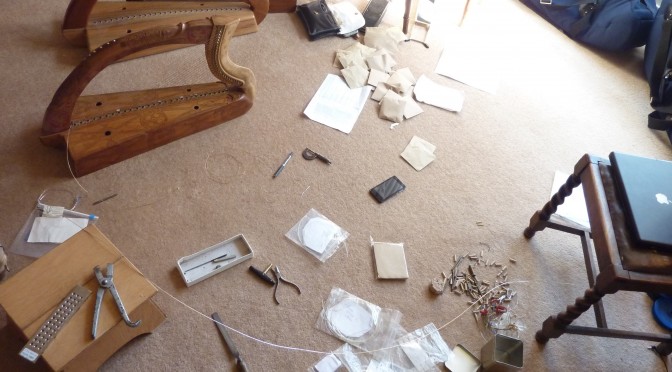I realised it would be somewhat hypocritical of me to recommend my new Trinity College & Queen Mary harp stringing and tuning schedule, with na comhluighe (the sisters) at middle c, if I didn’t put it onto my replica of the Queen Mary harp.
So, last Sunday’s work was to remove all of the old silver trebles and gold basses, and put on the new brass trebles and silver basses according to the new scheme.
I have had the old scheme, with silver trebles, on the harp now for just over two years. I had tuned the harp with two strings below cronan, giving a pitch of A370/495. I loved how the harp spoke at this pitch, one note higher than the normal setup of a baroque Irish harp. It worked very well for the Renaissance Scottish music, and for ceòl mór.
However, it still pushed me to play low on the harp, and I thought the lush all-silver-and-gold setup seemed over the top for a Renaissance setup… yet that was the music it suited best.
I have been very impressed with the hard, shrill, high medieval sound of the newly-restrung Student Trinity, shocked at how different it is from the usual 18th century setup we have become used to, intrigued how it suits medieval repertory so well and how the Renaissance and later repertory sits more uneasily on it.
My replica of the Queen Mary harp has significantly shorter string lengths than the Student Trinity across its range. (when new, its string lengths were within a few percent of Karen Loomis’s calculated lengths of the original Queen Mary harp as built with a flat belly). This reminded me of an old issue, the purpose of the added 30th tuning pin and string shoe on the Queen Mary harp. By shifting everything down one place, and gaining an extra treble position, the lengths become very similar to the Student Trinity.
The harp is now restrung with Malcolm Rose’s yellow brass in the treble and mid-range, and my hard-drawn sterling silver in the bass. I have waited a few days to allow the strings to bed in, so that my Youtube demonstration gives a fairer idea of how it sounds.
What have I learned so far from this ? Primarily, that the medieval Gaelic harps are not just cute petite versions of the baroque Irish harps. They need to be respected in their own right as medieval musical instruments. That they have a voice of their own, higher and more sizzling than the deep, growly voice of the baroque Irish harps. The logic of the medieval Gamut points to their range and tuning, and highlights archaic and more modern features of the baroque setup.
Most importantly, it highlights for me that a replica medieval Gaelic harp is not a very suitable instrument for playing the baroque Irish harp repertory.

Great work Simon! It’s interesting to compare this video with the one you made last year after the soundbox work. I think the sound of the harp has definitely improved. As you mention above, the previous set up was pushing you to play low on the harp. I can see your hands are now higher up the harp when you play. The new stringing plus higher hand position sounds like a winning combination. BTW, this is much closer to where the wear marks are on the original Queen Mary (e.g. where your hands are at 2:43 is spot on where the wear marks are deepest).
I am really impressed by your proposition and i would like to try on my own Queen-Mary replica. I have 2 Queen-Mary that i made myself and it would be interesting to compare.
But, as you maybe know, i don’t like brass and prefer the bronze strings.
Do you think that i could try to string one of my harps with your new chart for the silver bass strings and use bronze strings for the higher ones?
I will be at kilkenny this summer, will you be there?
Thank you for all you do around the clairseach.
(please, excuse me for my very bad english ; i hope that you understand me )
Best regards, Criddh!